Our plan: a couple of quick museum visits and a fair amount of relaxation, reading and restaurants, but, plans go awry as there is much, much more going on in the Berkshires than James Taylor at Tanglewood.
First of all, the Berkshires really are beautiful—mountainous on a human and green scale, lovely lakes and picturesque towns. Then, there are the museums. And that’s where we started with Mass MoCA in North Adams, Massachusetts.
A 45 minute drive from Lenox, our home base, North Adams is, or was, a gritty factory town. The former Arnold Print Works mill campus, vacant and dilapidated, was opened in 1999 as Mass MoCA. It is not a collecting museum; however, its exhibits are often long term or very long term. Mass MoCA expanded in 2008 and 2017 and now comprises 230,000 square feet in several buildings on 24 acres. Our planned 2 hour visit stretched to 5 hours, including a good lunch.
I had never seen a James Turrell exhibit, or installation, and at Mass MoCA you can visit 9 Turrell rooms, each an immersion, or submersion, into the effects that beautiful colored, misty, foggy and angled light can have on your senses. The largest room, “Perfectly Clear” requires 9 minutes of viewing time as the light changes in color, vibrates occasionally with strobe, settles and wows you. It was calming and meditative, but also exhilarating. The other 8 installation rooms were each uniquely sense challenging. Turrell’s installations will be there through 2018, at minimum.
Building 7 is comprised of 27,000 square feet and 3 floors of Sol LeWitt wall drawings, 105 of them covering 40 years of his prolific career. It will remain on view for 25 years (from 2008). The first floor is comprised of early career drawings, subtle grids of pencil and light washes of color or colored pencil. More theoretical than his later work, but they can at times seem almost Agnes Martin- like in their contemplative nature. The 2nd floor focuses on mid-career, probably my favorite period, colorful and bold and geometric. The ink washes are applied so perfectly and have beautiful mottled tonal ranges within blocks of color that humanize what can occasionally seem mechanized. The 3rd floor late career drawings are much more vibrant, using primary colors in shapes ranging from super tight squiggles, to bold splats of color to swirls of blocks, all brilliantly hued.
After that, what next? How about an out-building filled with an Anselm Kiefer exhibit. In one room, 30 encrusted organic paintings are displayed, many collaged with rusted sea vessels. Based on a Russian Futurist and poet’s theory that climactic sea battles have happened in a cycle of 317 years, the paintings, in their rough, tactile, built-up surfaces, loaded with rusty and earthy tones and the floating collaged iron ships are as close as I want to get to the roiling sea battles depicted. Beautiful and doomy.
There is much more at Mass MoCA, including an out-of-this-world Nick Cave installation, Louise Bourgeois, Jenny Holzer, Rauschenerg and much more. Too much for one day.
The next day we again violated our 2 hour rule and spent another 5 hours at the Clark Institute in Williamstown. The Clark is situated on a rolling hilled campus with paths and pools and a blending of quiet architectural elements that works perfectly. The town and the museum are the well-heeled cousin to gritty North Adams and Mass MoCA’s exposed masonry. An excellent collection of mainly European art (emphasis on Renoir). Also there is very nice Picasso show, 3 paintings and 35 larger prints from 1905 to 1970, and in a separate building, a short walk through a wooded path, a Helen Frankenthaler show—large canvases, maybe a dozen, all landscape based. It’s a perfect exhibit for the location, tranquil, pastoral, abstract.
On Saturday, we trek the short distance to Stockbridge for the Norman Rockwell Museum. It’s more fun than I expected. First, the historical aspects of his illustrative paintings, then the humor, then the humanity of his social conscience gradually defuse my cynicism. As a bonus, there is Warhol/Rockwell show, wherein Warhol’s Jackie is presented next to Rockwell’s…and other moments of historical import are seen through the eyes of 2 very different artist/voyeurs.
The Frelinghuysen Morris House and Studio sits back off the road down a long wooded driveway in the 1950’s modern house built by George LK Morris and his wife, Suzy Frelinghuysen. Both were early proponents of abstract painting in America, having spent considerable time with their Parisian counterparts Braque, Gris, Klee, Picasso and Miro. Their paintings, roughly 1930-1970s are modernist American art at its height. Along with Charles Shaw and Albert Gallatin (the Park Avenue Cubists), they embodied an important era in American art. The house is the perfect showcase for this. The curved walls, painted with their own fresco abstracts, other paintings of their own, plus Shaw’s and Gallatin’s are mixed in with their own significant collection of Braque, Miro, Gris, Picasso and Klee paintings. Large windows look out on a beautiful park-like setting. This was a completely unexpected treat as you see how they lived, their studio, their travels and their legacy. Ultra-cool!
An evening at Tanglewood with the Boston Pops, a hike in the morning and we’re off to the airport. All in all, a pretty groovy trip and highly recommended for art lovers, music lovers and nature lovers.
–Kevin Ott








